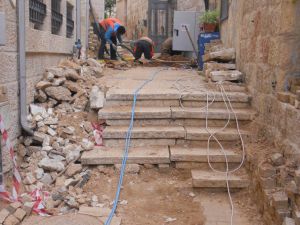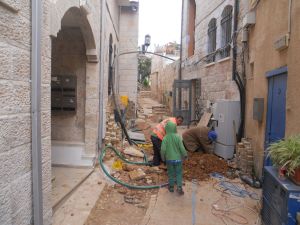Alleyways that previously could only allow two people to pass abreast now have the capacity for an entire pedestrian to trip into one of the many open ditches and break as many as eighteen bones at once.
Jerusalem, January 26 – A new series of road and infrastructure improvements to the capital city began last week, and are scheduled to last several weeks, projects that municipal officials say will thrust Jerusalem forward into the twentieth century.
Long an amalgamation of modern architecture and transportation needs with decaying, nineteenth-century infrastructure, Jerusalem has in recent years undergone a gradual shift from inadequate, Ottoman-era facilities to differently inadequate Israeli-era roads, electricity, telephone, and sewer systems. The shift has mirrored architectural development in the city, with dilapidated shacks cheek-by-jowl with newer, poorly constructed buildings.
Construction crews have been working at dozens of sites for more than a week already, replacing some of the often-hazardous and frequently unreliable drainage systems with piles of dirt and rubble. Alleyways that previously could only allow two people to pass abreast now have the capacity for an entire pedestrian to trip into one of the many open ditches and break as many as eighteen bones at once.
“It’s always a challenge to maintain allegiance to a city’s architectural history while enabling a modern, vibrant, forward-thinking lifestyle,” says Mayor Nir Barkat. “We accept that challenge, and our method of negotiating it involves a compromise: we will only bring the city part of the way forward and stop there.” In the present case, says Barkat, the lineup of projects replaces, for example, outdated and crumbling pipes with state-of-the-art leaky pipes.
“Many of the drainage ducts and grates have been clogged for years, if not decades,” observes Project Manager Albiyeh Mezayyef. “Several old alleys in the center of town have stairways that transform into waterfalls when it rains so much as a millimeter – the storm drain grates halfway up the alley back up every time. Our job is to dig up the entire street, taking care not to touch the drainage pipes, and replace the electrical cables.”
Mezayyef said he expected the city to undertake the sewage duct work only after the pavement and steps have been repaired, at which point an entirely new crew will have to tear up the street again. “It’s a pain for the residents, I know – but where I live, in the eastern section of the city, we are lucky – we never have to worry that the municipality will do anything to improve the infrastructure.”






